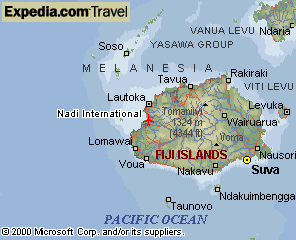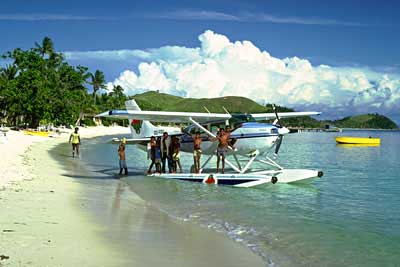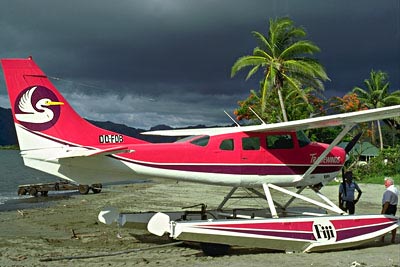
Floats & Frangipani!
 Part Two
Part Two
![]()
maps.expedia.com

Regardless of the problems, for every bad day in Fiji there are always
plenty of good days to compensate. Who could fault, for instance, a
typical Fijian morning? Greeted by crowing roosters, the golden sun
quickly establishes its predominance over the tranquil countryside.
Coconut palms line the beach of Nadi Bay; the sea is glassy calm with only
a barely perceptible surge, like a passing mirage, that builds and breaks
upon the shore in a rush, tinkling thousands of empty seashells together
like musical wind chimes. The air is still and heavy, and sweet with the
fragrance of flowers. Hibiscus, frangipani, and bougainvillea are in bloom
everywhere. Green parrot finches, sporting bright red prayer caps, flit
from branch to branch in heavily-laden breadfruit trees. As I walk to work
along the beach, local Indian herdsmen prod massive oxen solemnly past me
on their way to freshly cut sugar cane fields.
![]() Because I
was born and raised in an environment of tamarack trees and spruce grouse,
snow drifts and snowshoe rabbits, the morning scenery feels foreign to me.
I have to ask myself, "What am I doing here?" Although I know I
can enjoy the experience of being in Fiji, I only really feel comfortable
when I climb into the familiar cockpit of my floatplane. I am right at
home each morning as the 206 coughs into a throaty roar.
Because I
was born and raised in an environment of tamarack trees and spruce grouse,
snow drifts and snowshoe rabbits, the morning scenery feels foreign to me.
I have to ask myself, "What am I doing here?" Although I know I
can enjoy the experience of being in Fiji, I only really feel comfortable
when I climb into the familiar cockpit of my floatplane. I am right at
home each morning as the 206 coughs into a throaty roar.
Click
on the images for a larger view

Turtle Airways' seaplane base, known locally
as the "boat club," is right beside the international airport's
main runway, 03-21, that parallels the shoreline. Before take-off we call
in, "Nadi Tower, good morning, Foxtrot Charlie Uniform on the water
at the boat club, five persons on board for Mana Island; two plus three -
zero hours fuel; will call you airborne." The resort islands we
service - Castaway, Club Naitasi, Plantation, Treasure, Beachcomber,
Navini, and Mana, and the Fijian Resort on the southern Coral Coast - are
all within 15 minutes flying from the base. And because in Fiji all
aircraft must maintain radio contact with the appropriate air traffic
control tower at all times, we also call when landing, and again on
departure. Thus, we always fly in a control zone.
![]() To reach
Mana Island, our busiest run, I climb out due west from Nadi levelling out
at 1,000 asl. The flight across, when the sea is still calm, is a good
time to spot giant sea turtles, wandering reef sharks, barrel rolling
manta rays, and occasional humpback whales cruising the numerous coral
reefs. At Mana, we land inside the southern coral reef that protects a
beautiful, blue-green lagoon two kilometers long and 1/2 km wide from the
relentless ocean swells on all but the highest tides.
To reach
Mana Island, our busiest run, I climb out due west from Nadi levelling out
at 1,000 asl. The flight across, when the sea is still calm, is a good
time to spot giant sea turtles, wandering reef sharks, barrel rolling
manta rays, and occasional humpback whales cruising the numerous coral
reefs. At Mana, we land inside the southern coral reef that protects a
beautiful, blue-green lagoon two kilometers long and 1/2 km wide from the
relentless ocean swells on all but the highest tides.
![]() From the
air, the crystal clear waters are naturally color coded for take-off and
landing depths. Blue is deep water. Green is shallow water with a sandy
bottom, but is also safe. Brown is dead coral that appears above the low
tide mark, and as Ralph Nader would say, "is not safe at any
speed." Only at high tide can the plane taxi clear over certain brown
corals, but the pilot has to be selective and cautious.
From the
air, the crystal clear waters are naturally color coded for take-off and
landing depths. Blue is deep water. Green is shallow water with a sandy
bottom, but is also safe. Brown is dead coral that appears above the low
tide mark, and as Ralph Nader would say, "is not safe at any
speed." Only at high tide can the plane taxi clear over certain brown
corals, but the pilot has to be selective and cautious.
![]() The only seaplane docks in Fiji are at our base and at Turtle Island
Lodge. Therefore, in Mana, I taxi up to the beach and, stepping into
knee-deep water, I heel the plane up on the soft coral sand. With an
incoming tide and an onshore breeze, I can leave the plane unattended, but
if the tide is going out, I have to keep the 206 from getting stranded. In
the afternoon, I am normally swamped with tourists (bored with laying on
the beach) asking questions, or taking pictures of the "barefoot
captain," and "Turtle." Because our flying schedule is set
out the day before, I know when there is time to moor the plane and cool
off by going for a swim. In addition, I know the boys who run the resort's
water sports so I can spend time sailing the hobie cats or wind surfers.
The only seaplane docks in Fiji are at our base and at Turtle Island
Lodge. Therefore, in Mana, I taxi up to the beach and, stepping into
knee-deep water, I heel the plane up on the soft coral sand. With an
incoming tide and an onshore breeze, I can leave the plane unattended, but
if the tide is going out, I have to keep the 206 from getting stranded. In
the afternoon, I am normally swamped with tourists (bored with laying on
the beach) asking questions, or taking pictures of the "barefoot
captain," and "Turtle." Because our flying schedule is set
out the day before, I know when there is time to moor the plane and cool
off by going for a swim. In addition, I know the boys who run the resort's
water sports so I can spend time sailing the hobie cats or wind surfers.
![]() Sometimes,
we do scenic flights off Mana Island for the Japanese tourists. My
favorite scenic includes a low buzz over Robinson Crusoe Island, where the
resort's boat drops off honeymoon couples to be "alone" for the
day. My clients grin from ear to ear when we often catch the honeymooners
taking advantage of their isolation. After the flight, the Japanese
gentleman smiles and says in labored English, "Tank-you velly much,
pirot, we had velly nice fright."
Sometimes,
we do scenic flights off Mana Island for the Japanese tourists. My
favorite scenic includes a low buzz over Robinson Crusoe Island, where the
resort's boat drops off honeymoon couples to be "alone" for the
day. My clients grin from ear to ear when we often catch the honeymooners
taking advantage of their isolation. After the flight, the Japanese
gentleman smiles and says in labored English, "Tank-you velly much,
pirot, we had velly nice fright."
![]() Later in
the morning, back on Viti Levu, convection heating on the land starts
drawing in cooler ocean breezes, forming billowing white cumulus clouds.
Numerous sugar cane fields, like lumpy patchwork quilts, spread out toward
the distant shimmering green foothills of the Nausori Highlands. Flying
low over the fields, you can still see oxen, harnessed in traditional
wooden yokes, pulling ploughshares through the reddish volcanic soils, and
in the narrow brown rivers snaking down to Nadi Bay, sunbaked Fijian women
still gather to beat their clothes clean on the smooth black rocks. Back
at the base, I land beyond Indian fishermen, waist deep in the silty
waters, pulling in hand-nets dotted with shiny plaice. I can't help but
notice the contrast between the simple fishermen and tourists I am about
to pick up.
Later in
the morning, back on Viti Levu, convection heating on the land starts
drawing in cooler ocean breezes, forming billowing white cumulus clouds.
Numerous sugar cane fields, like lumpy patchwork quilts, spread out toward
the distant shimmering green foothills of the Nausori Highlands. Flying
low over the fields, you can still see oxen, harnessed in traditional
wooden yokes, pulling ploughshares through the reddish volcanic soils, and
in the narrow brown rivers snaking down to Nadi Bay, sunbaked Fijian women
still gather to beat their clothes clean on the smooth black rocks. Back
at the base, I land beyond Indian fishermen, waist deep in the silty
waters, pulling in hand-nets dotted with shiny plaice. I can't help but
notice the contrast between the simple fishermen and tourists I am about
to pick up.
![]() About 10
a.m. daily, we run guests and supplies up to Turtle Island Lodge. Taking a
heading of 345 magnetic, I fly straight across Bligh Waters to intersect
Turtle Island, 28 minutes later, about half-way up the Yasawa Island
chain. Here we land in the waters made famous by the 1948 movie starring
Jean Simmons, and the 1979 movie starring Brooke Shields - both
appropriately titled The Blue Lagoon, and both filmed entirely on Turtle
Island.
About 10
a.m. daily, we run guests and supplies up to Turtle Island Lodge. Taking a
heading of 345 magnetic, I fly straight across Bligh Waters to intersect
Turtle Island, 28 minutes later, about half-way up the Yasawa Island
chain. Here we land in the waters made famous by the 1948 movie starring
Jean Simmons, and the 1979 movie starring Brooke Shields - both
appropriately titled The Blue Lagoon, and both filmed entirely on Turtle
Island.
![]() The
island's American owner, Richard Evanson, and Fijian staff greet guests
and pilot alike with freshly made lemon, papaya, or mango juice. Richard
originally started Turtle Airways to provide himself with a fast,
dependable link to civilization, and to transfer his lodge's guests. He
later sold the airline to South Sea Island Cruises, the present owners.
The
island's American owner, Richard Evanson, and Fijian staff greet guests
and pilot alike with freshly made lemon, papaya, or mango juice. Richard
originally started Turtle Airways to provide himself with a fast,
dependable link to civilization, and to transfer his lodge's guests. He
later sold the airline to South Sea Island Cruises, the present owners.
The new
lodge arrivals are quickly led away to their cottages, and outbound guests
are bestowed with champagne and leis and serenaded with the touching
Fijian farewell song, I sa lei. As well-wishers crowd the sinking dock,
the scene blends into a mawkish display of singing Fijians, guitars,
sunburned tourists, cameras, laughing children, flowers, crying women,
goodbye kisses, and barking dogs - that to the hardened pilot only
represents a delay in a busy schedule. To leave on time, he usually plays
the spoil-sport by physically "guiding" the reluctant guests
aboard the airplane. The guests suddenly come their more dignified senses
when the music stops and the engine starts.
![]() As my
keels cut across the lagoon's waters, I am also aware of a quite different
existence below the surface. If I have to wait on the islands, I pass my
time by skin-diving among color-washed corals and riots of colorful
tropical fish: brilliant orange and white clownfish, green hued
parrotfish, and flashy blue angelfish that are all fascinating to watch as
they dart among the tentacled sea anemones and staghorn corals.
Consequently, I almost spend as much time in the water as I do on the
water.
As my
keels cut across the lagoon's waters, I am also aware of a quite different
existence below the surface. If I have to wait on the islands, I pass my
time by skin-diving among color-washed corals and riots of colorful
tropical fish: brilliant orange and white clownfish, green hued
parrotfish, and flashy blue angelfish that are all fascinating to watch as
they dart among the tentacled sea anemones and staghorn corals.
Consequently, I almost spend as much time in the water as I do on the
water.
![]() On one
occasion last winter, when I stayed overnight in the islands, I went for a
long relaxing sunset swim in the warm, placid waters. Reaching official
darkness only 15 minutes after sunset near the equator, the sky quickly
turned from blue to golden to a vermilion glow, flaming like a forest fire
in the night, as the day ended in a spectrum of fading light.
On one
occasion last winter, when I stayed overnight in the islands, I went for a
long relaxing sunset swim in the warm, placid waters. Reaching official
darkness only 15 minutes after sunset near the equator, the sky quickly
turned from blue to golden to a vermilion glow, flaming like a forest fire
in the night, as the day ended in a spectrum of fading light.
![]() Venus
boldly appeared first on the far horizon, and the constellation Orion,
bright as on any indigo arctic night, followed soon after. I began to feel
right at home under the stars, except that high in the unfamiliar southern
sky was the predominant Southern Cross sparkling and flickering down on
me. Then I was surprised, naturally enough, to make out Ursa Major, turned
upside down on the northern horizon. Not all of it, mind you, but the
panhandle and three of the corner stars of the Big Dipper. I was intrigued
that from my position in Fiji I could see both hemisphere's representing
constellations in the same sky, but from home I could not see the Southern
Cross.
Venus
boldly appeared first on the far horizon, and the constellation Orion,
bright as on any indigo arctic night, followed soon after. I began to feel
right at home under the stars, except that high in the unfamiliar southern
sky was the predominant Southern Cross sparkling and flickering down on
me. Then I was surprised, naturally enough, to make out Ursa Major, turned
upside down on the northern horizon. Not all of it, mind you, but the
panhandle and three of the corner stars of the Big Dipper. I was intrigued
that from my position in Fiji I could see both hemisphere's representing
constellations in the same sky, but from home I could not see the Southern
Cross.
![]() Later,
applying the analogy to Canada and Fiji, I realized that living in Fiji
has allowed me to observe and compare the two countries - the flying, the
people, the way of life, the scenery - but if I had stayed in Canada I
would have missed that opportunity. What I discovered in my comparisons,
moreover, was that although everything else may feel foreign, the
experience of flying remains the same. Whether flying off Canada's
northern lakes, or off South Pacific beaches, the problems facing all bush
pilots are universal.
Later,
applying the analogy to Canada and Fiji, I realized that living in Fiji
has allowed me to observe and compare the two countries - the flying, the
people, the way of life, the scenery - but if I had stayed in Canada I
would have missed that opportunity. What I discovered in my comparisons,
moreover, was that although everything else may feel foreign, the
experience of flying remains the same. Whether flying off Canada's
northern lakes, or off South Pacific beaches, the problems facing all bush
pilots are universal.
The only real difference is that here in Fiji, we
fly in bare feet.
Article and Images by John S Goulet
![]()
Note from the Editor. Part Two completes the story. GPS, storm scopes, and Caravans with radar have made the basics all that much easier than 15 years ago. But, still, I find the flying remains the same. For more flying stories let the attitude indicator take you back to Feature Stories.
 Top of this story.
Top of this story.
Part One of Floats & Frangipani!
Last modified on April 21st, 2000.
© Virtual Horizons, 1996.

